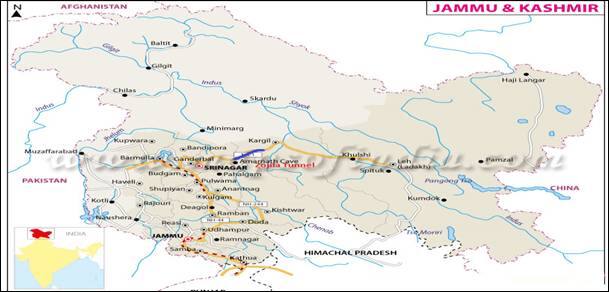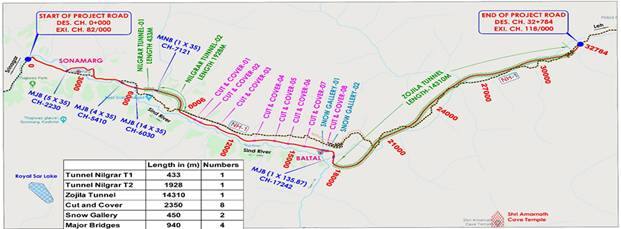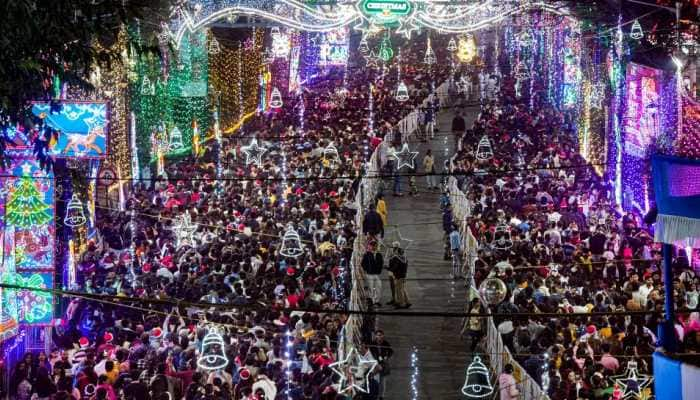Union Minister Nitin Gadkari to initiate first blasting of Zozila Tunnel on October 15, know its salient features
Prime Minister Narendra Modi laid the foundation stone at Leh and commenced the work on May 19, 2018.
- It involves the construction of a 14.15 km long tunnel at an altitude of about 3000 m under the Zojila pass (presently motorable only for 6 months in a year) on NH-1 connecting Srinagar and Leh through Dras and Kargil.
- It is one of the most dangerous stretches in the world to drive a vehicle and this project is also geo-strategically sensitive.
- This Project will make the travel on the Srinagar-Kargil-Leh Section of NH-1 free from avalanches.
Trending Photos
) File Photo
File Photo New Delhi: Union Minister for Road Transport, Highways and MSMEs Nitin Gadkari will initiate the first blasting for Zozila Tunnel in Jammu and Kashmir on Thursday (October 15, 2020). The tunnel will provide all-weather connectivity between Srinagar valley and Leh (Ladakh plateau) on NH-1 and will bring about an all-round economic and socio-cultural integration of Jammu & Kashmir (now UTs of J&K and Ladakh).
It involves the construction of a 14.15 km long tunnel at an altitude of about 3000 m under the Zojila pass (presently motorable only for 6 months in a year) on NH-1 connecting Srinagar and Leh through Dras and Kargil.
It is one of the most dangerous stretches in the world to drive a vehicle and this project is also geo-strategically sensitive.
The project was first conceived in 2005 and its Detailed Project Report (DPR) was prepared by BRO in the year 2013 on BOT (Annuity) mode. Attempts to award the project four times weren’t successful.
The Project was eventually given to NHIDCL in July 2016 for implementation on EPC mode. Its work was awarded to M/s. ITNL (IL&FS).
Prime Minister Narendra Modi laid the foundation stone at Leh and commenced the work on May 19, 2018.

The work progressed up to July 2019, and thereafter M/s. IL&FS went into financial problems and the project was stuck. Hence, the contract was terminated on January 15, 2019.
Thereafter, in February 2020, Gadkari reviewed this whole project in detail.
In order to reduce the cost and to execute the languishing project on priority, referred the matter to an expert group under the Chairmanship of I.K Pandey, DG (RD) & SS, MoRTH. The Expert group suggested modalities of project configuration and implementation, to achieve project completion in the least possible time and cost.

After due consultation with tunnel experts and other stakeholders, the expert group submitted its report on 17.5.2020, which was approved by the Minister, RTH on 23.05.2020.
The salient features of the report include the following:
(i) Construction of two-lane Bi-directional single tube tunnel without parallel egress/escape passage.
(ii) Reduction in construction shafts from 3 to 2.
(iii) The Design Speed in the tunnel to be 80 KMPH.
(iv) Adding approach road of 18 km (Net road length is 12 KM) from the end of Z-Morh tunnel to start of Zozila tunnel with Avalanche protection structures such as Catch Dams, Snow Galleries, Cut & Cover, Deflector Dam, etc. to make it an all-weather connection between two tunnels.
(v) The modified cost worked out was Rs. 4429.83 crores and it would reduce the travel time from more than 3.5 Hours currently to just 15 Minutes to travel through the tunnel.
(vi) To take up the integrated project of Zozila tunnel and approach road from Z-Morh to Zozila with avalanche protection for all-weather connectivity.

Significance of the project:
(i) The construction of Zojila Tunnel will provide all-weather safe connectivity between Srinagar, Dras, Kargil and Leh regions. The all-weather safe connectivity of the road is immensely important from the strategic point of view.
(ii) The construction of Zozila Tunnel shall bring about all-round economic and socio-cultural integration of these regions which remains cut-off from the rest of the country during winters due to heavy snowfall for about six months.
(iii) A tunnel in Zozila is the only viable alternative at present for a full year connectivity road. This tunnel when completed will be a landmark achievement in the history of modern India. It will also be of great importance to the Defence of the country, in view of the fact that massive military activities along our borders in Ladakh, Gilgit and Baltistan regions are taking place.
(iv) Zozila Tunnel project shall bring to fruition, 30 years of overwhelming public demand of Kargil, Drass and Ladakh region.
(v) This Project will make the travel on the Srinagar-Kargil-Leh Section of NH-1 free from avalanches.
(vi) Project would enhance the safety of the travellers crossing Zozila Pass and would reduce the Travel time from more than 3 hours to 15 minutes.

Safety features of Zozilla Tunnel:
1. Emergency lay-bys are located at intervals of 750 m staggered on both sides of the carriageway. There are sidewalks on both sides of the carriageway. Emergency call niches and hydrant niches are situated at intervals of 125 m.
2. Manual fire alarm push buttons and portable fire extinguishers shall be at the disposal of all drivers.
3. A telephone shall be installed at the emergency call niches.
4. Fire Hydrants and Hydrant Niches, Fire Extinguishers.
5. Tunnel Lighting Systems: The Tunnel Lighting System represents the most significant part of the tunnel traffic safety and shall cover the following needs: Entrance lighting (in the accommodation sections at both ends of the tunnel), Interior lighting (through the whole tunnel) and Lay-bys lighting.

6. Video Surveillance system - CCTV-Cameras: The surveillance cameras in the tunnel shall be installed on the tunnel wall and the cameras in the area before and after the tunnel are installed on a pole. Data and video mage shall be transmitted through the communications lines. To achieve this, transceivers and media converter shall be employed.
7. Fire Alarm System in buildings.
8. Automatic Fire Detection and suppression System in the tunnel.
9. Linear heat detection systems shall be connected to the SCADA system through its own control system.

10. Emergency Telephone Niches: Emergency call niches shall be located, according to the EU standard, in the tunnel at intervals of less than 125 m each to other in the tunnel and in all lay-bys. The emergency points shall have the following equipment: Fire alarm push buttons and Fire extinguishers.
10. Traffic control system with a central control room.
Stay informed on all the latest news, real-time breaking news updates, and follow all the important headlines in india news and world News on Zee News.
Live Tv







)
)
)
)
)
)
)
)
)
)
